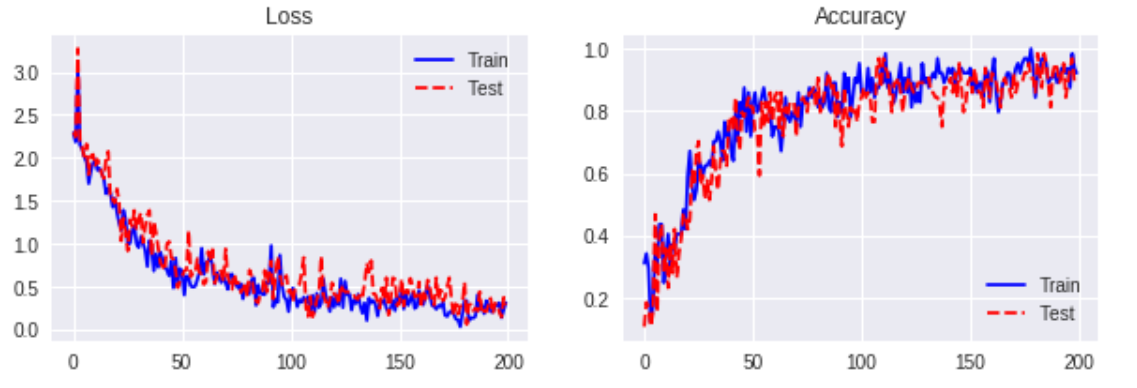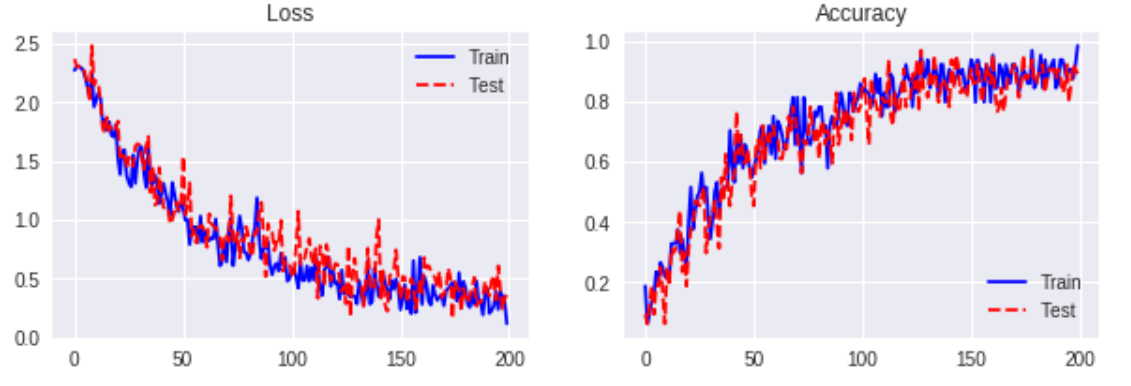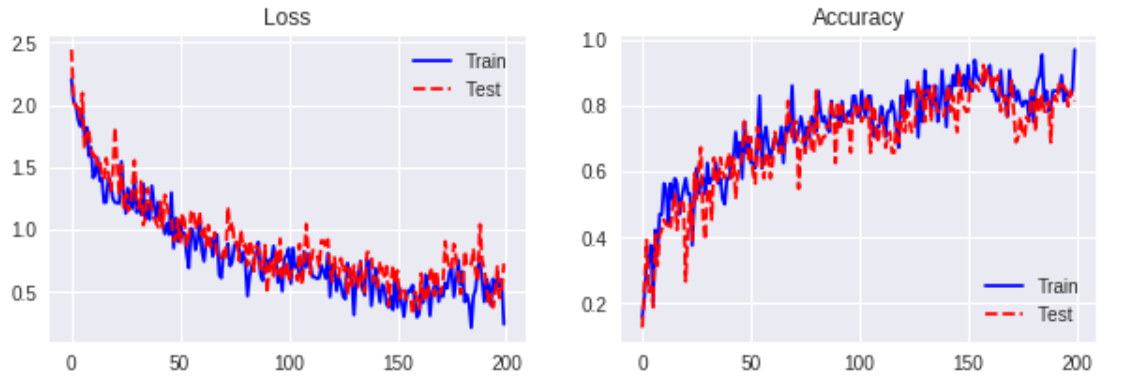ポイント
- Gated CNN を実装し、MNIST 手書き数字データでパフォーマンスを検証。
- 4パターン( GLU、GTU、ReLU、Tanh ) を比較。
- 今後、Sequential MNIST、Permuted MNIST で追加検証。
レファレンス
1. Language Modeling with Gated Convolutional Networks
2. An Empirical Evaluation of Generic Convolutional and Recurrent Networks for Sequence Modeling
検証方法
- MNIST手書き数字データを使用。28x28。
- Residual Block、Regularization、Gradient Clipping を適用せずに、4パターンを比較。
データ
MNIST handwritten digits
from tensorflow.examples.tutorials.mnist import input_data
mnist = input_data.read_data_sets('***/mnist', \
one_hot = True)
検証結果
数値計算例:
- n_in = 28*28
- filter_size = 5
- n_units = 32
- n_out = 10
- n_layers = 7
- learning_rate = 0.01
- batch_size = 64
サンプルコード
def gated_conv(self, x, shape):
w = self.weight_variable('w', shape)
b = self.bias_variable('b', shape[-1])
v = self.weight_variable('v', shape)
c = self.bias_variable('c', shape[-1])
f = tf.add(tf.nn.conv2d(x, w, strides = [1, 1, 1, 1], \
padding = 'VALID'), b)
g = tf.add(tf.nn.conv2d(x, v, strides = [1, 1, 1, 1], \
padding = 'VALID'), c)
output1 = tf.multiply(f, tf.sigmoid(g)) # GLU
output2 = tf.multiply(tf.tanh(f), tf.sigmoid(g)) # GTU
output3 = tf.nn.relu(f) # ReLU
output4 = tf.tanh(f) # Tanh
return output4
# without residual block
def inference(self, x, filter_size, n_in, n_units, \
n_out, n_layers):
width = np.sqrt(n_in).astype(np.int32)
channel = np.sqrt(n_in).astype(np.int32)
x = tf.reshape(x, [-1, 1, width, channel])
shape = [1, 1, channel, n_units]
with tf.variable_scope('initial'):
y = self.conv(x, shape)
shape = [1, filter_size, n_units, n_units]
for i in range(n_layers):
with tf.variable_scope('layer_{}'.format(i + 1)):
y = tf.pad(y, [[0, 0], [0, 0], \
[filter_size - 1, 0], [0, 0]])
y = self.gated_conv(y, shape)
y = y[:, :, -1, :]
y = tf.squeeze(y, axis = 1)
with tf.variable_scope('final'):
w = self.weight_variable('w', [n_units, n_out])
b = self.bias_variable('b', [n_out])
y = tf.add(tf.matmul(y, w), b)
y = tf.nn.softmax(y, axis = 1)
return y
def loss(self, y, t):
cross_entropy = - tf.reduce_mean(tf.reduce_sum( \
t * tf.log(tf.clip_by_value(y, 1e-10, 1.0)), axis = 1))
return cross_entropy
# without gradient clipping
def training(self, loss, learning_rate):
optimizer = tf.train.AdamOptimizer(learning_rate = \
learning_rate)
train_step = optimizer.minimize(loss)
return train_step
def accuracy(self, y, t):
correct_preds = tf.equal(tf.argmax(y, axis = 1), \
tf.argmax(t, axis = 1))
accuracy = tf.reduce_mean(tf.cast(correct_preds, \
tf.float32))
return accuracy
def fit(self, images_train, labels_train, images_test, \
labels_Test, filter_size, n_in, n_units, \
n_out, n_layers, learning_rate, n_iter, \
batch_size, show_step, is_saving, model_path):
tf.reset_default_graph()
x = tf.placeholder(shape = [None, n_in], \
dtype = tf.float32)
t = tf.placeholder(shape = [None, n_out], \
dtype = tf.float32)
# without residual block
y = self.inference(x, filter_size, n_in, n_units, \
n_out, n_layers)
loss = self.loss(y, t)
train_step = self.training(loss, learning_rate)
acc = self.accuracy(y, t)
init = tf.global_variables_initializer()
saver = tf.train.Saver()
with tf.Session() as sess:
sess.run(init)
history_loss_train = []
history_acc_train = []
history_loss_test = []
history_acc_test = []
for i in range(n_iter):
# Train
rand_index = np.random.choice(len(images_train), \
size = batch_size)
x_batch = images_train[rand_index]
y_batch = labels_train[rand_index]
feed_dict = {x: x_batch, t: y_batch}
sess.run(train_step, feed_dict = feed_dict)
temp_loss = sess.run(loss, feed_dict = feed_dict)
temp_acc = sess.run(acc, feed_dict = feed_dict)
history_loss_train.append(temp_loss)
history_acc_train.append(temp_acc)
if (i + 1) % show_step == 0:
print ('--------------------')
print ('Iteration: ' + str(i + 1) + ' Loss: ' \
+ str(temp_loss) + ' Accuracy: ' \
+ str(temp_acc))
# Test
rand_index = np.random.choice(len(images_test), \
size = batch_size)
x_batch = images_test[rand_index]
y_batch = labels_test[rand_index]
feed_dict = {x: x_batch, t: y_batch}
temp_loss = sess.run(loss, feed_dict = feed_dict)
temp_acc = sess.run(acc, feed_dict = feed_dict)
history_loss_test.append(temp_loss)
history_acc_test.append(temp_acc)
if is_saving:
model_path = saver.save(sess, model_path)
print ('done saving at ', model_path)
fig = plt.figure(figsize = (10, 3))
ax1 = fig.add_subplot(1, 2, 1)
ax1.plot(range(n_iter), history_loss_train, \
'b-', label = 'Train')
ax1.plot(range(n_iter), history_loss_test, \
'r--', label = 'Test')
ax1.set_title('Loss')
ax1.legend(loc = 'upper right')
ax2 = fig.add_subplot(1, 2, 2)
ax2.plot(range(n_iter), history_acc_train, \
'b-', label = 'Train')
ax2.plot(range(n_iter), history_acc_test, \
'r--', label = 'Test')
ax2.set_title('Accuracy')
ax2.legend(loc = 'lower right')
plt.show()



